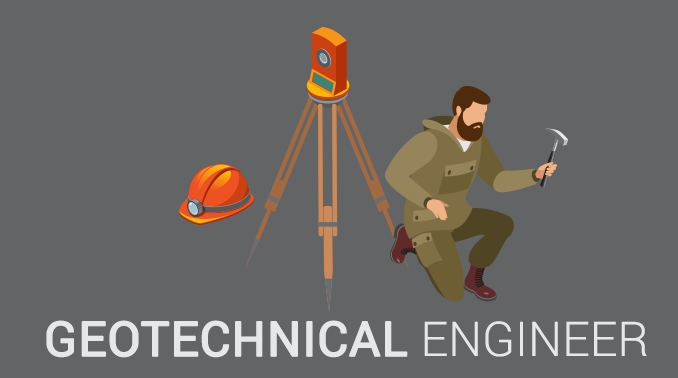Examine This Report on Geotheta
Examine This Report on Geotheta
Blog Article
The Single Strategy To Use For Geotheta
Table of ContentsRumored Buzz on GeothetaGeotheta Fundamentals ExplainedIndicators on Geotheta You Should KnowWhat Does Geotheta Mean?The Best Strategy To Use For Geotheta

They perform website examinations, gather samples, perform lab tests, and analyze information to evaluate the suitability of the ground for construction projects - Engineer of Record. Based on their searchings for, geotechnical designers provide suggestions for structure design, slope security, keeping frameworks, and mitigation of geotechnical threats. They work together with other specialists, such as engineers, structural designers, and construction teams, to ensure that geotechnical considerations are integrated right into the overall project layout and execution
By examining the habits and buildings of soil and rock, they can determine potential geotechnical risks such as landslides, soil settlement, or slope instability. Their experience aids prevent failings or mishaps that can jeopardize lives and residential or commercial property. Below are some detailed obligations and responsibilities of a geotechnical designer: Site Examination: Geotechnical designers conduct website examinations to collect information on subsurface conditions.
They analyze the information to understand the residential properties and habits of the soil and rock, including their stamina, leaks in the structure, compaction attributes, and groundwater conditions. Geotechnical Evaluation and Style: Geotechnical designers assess the data gathered throughout website examinations to assess the security and suitability of the site for building and construction tasks. They execute geotechnical calculations and modeling to assess variables such as birthing capacity, settlement, incline security, side earth pressures, and groundwater circulation.
The 7-Minute Rule for Geotheta
Structure Style: Geotechnical designers play a critical role in designing foundations that can safely sustain the designated structure. They examine the dirt problems and load requirements to determine the proper foundation type, such as superficial structures (e.g., footings), deep structures (e.g (https://experiment.com/users/geotheta)., heaps), or specialized techniques like dirt enhancement. They take into consideration factors such as negotiation limits, bearing ability, and soil-structure interaction to create optimal foundation styles
They assess building plans, screen website tasks, and perform area examinations to confirm that the design recommendations are complied with. If unpredicted geotechnical problems develop, they analyze the scenario and offer recommendations for removal or changes to the design. Risk Assessment and Mitigation: Geotechnical designers evaluate geotechnical risks and risks related to the task website, such as landslides, liquefaction, or dirt disintegration.

Cooperation and Interaction: Geotechnical designers function carefully with other specialists included in a project, such as engineers, architectural designers, and building and construction groups. Effective interaction and partnership are essential to incorporate geotechnical factors to consider into the overall task style and construction procedure. Geotechnical engineers provide technological proficiency, solution questions, and ensure that geotechnical needs are fulfilled.
What Does Geotheta Mean?
Here are some sorts of geotechnical designers: Foundation Designer: Structure designers specialize in making and examining structures for structures. They examine find the dirt conditions, load demands, and website features to determine the most proper structure kind and style, such as superficial structures, deep structures, or specialized techniques like pile structures.
They assess the aspects affecting incline stability, such as soil residential or commercial properties, groundwater conditions, and slope geometry, and develop techniques to avoid incline failures and reduce dangers. Quake Designer: Earthquake engineers focus on assessing and making frameworks to hold up against seismic pressures. They analyze the seismic danger of a website, examine soil liquefaction capacity, and establish seismic style requirements to guarantee the security and durability of structures during earthquakes.
They do area screening, accumulate examples, and analyze the gathered data to identify the soil residential or commercial properties, geologic formations, and groundwater problems at a site. Geotechnical Instrumentation Engineer: Geotechnical instrumentation designers concentrate on monitoring and gauging the actions of dirt, rock, and frameworks. They install and keep instrumentation systems that check variables such as soil settlement, groundwater levels, incline activities, and architectural variations to assess efficiency and supply early warnings of prospective concerns.
Geotheta Fundamentals Explained
They carry out tests such as triaxial tests, combination examinations, direct shear examinations, and permeability tests to collect data for geotechnical analysis and design. Geosynthetics Engineer: Geosynthetics engineers specialize in the style and application of geosynthetic products, such as geotextiles, geogrids, and geomembranes. They utilize these products to improve soil security, enhance inclines, provide drain remedies, and control erosion.
They have a tendency to be investigatory people, which suggests they're intellectual, introspective, and curious. They are interested, systematic, logical, analytical, and sensible. Some of them are also social, meaning they're kind, generous, cooperative, individual, caring, handy, empathetic, sensible, and pleasant - Consulting Engineer.
In the workplace setting, geotechnical engineers use specialized software program tools to perform estimations, create designs, and examine data. They prepare records, testimonial task specs, connect with customers and employee, and coordinate task activities. The office setup gives a helpful environment for research, analysis, and collaboration with various other professionals associated with the task.
Geotheta for Beginners
They regularly visit project sites to carry out website examinations, assess geotechnical conditions, and collect data for evaluation. These check outs involve taking a trip to various areas, sometimes in remote or challenging surfaces. Geotechnical engineers may perform soil sampling, conduct examinations, and display building and construction activities to make sure that the geotechnical facets of the project are being applied appropriately.
Geotechnical engineers additionally operate in specialized geotechnical labs. In these centers, they conduct experiments, execute examinations on soil and rock samples, and examine the engineering residential or commercial properties of the products. Geotechnical research laboratory designers work extensively in these settings, taking care of screening devices, running tools, and videotaping data. They team up with other laboratory staff to guarantee precise and reputable screening outcomes.
Report this page